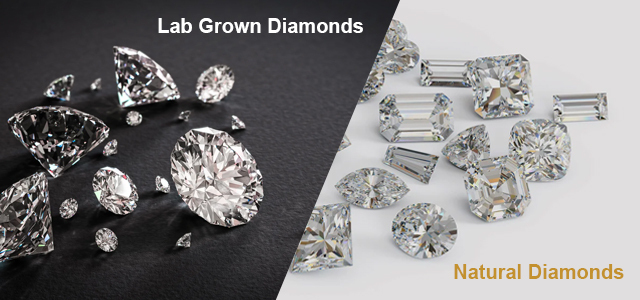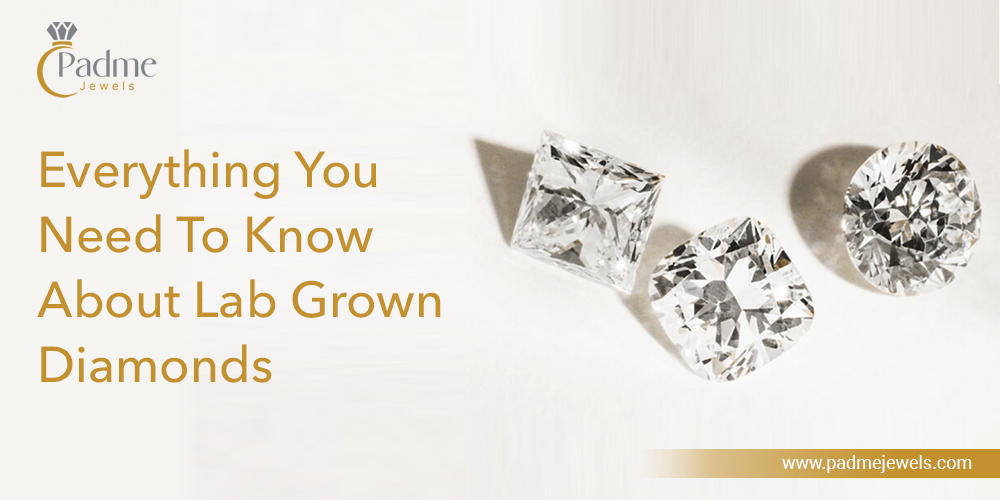General
Everything you need to know about Lab Grown Diamonds
Generally, people are often unsure to buy Lab-grown diamonds since they have a fear of purchasing them and not finding them to be “real diamonds”. Typically, Lab-grown diamonds are considered as “fake” due to it being termed as “synthetic diamonds” but in reality, they are created and manufactured in a lab with the same quality as a real diamond.
We are here to clear this air for you and in the blog below, we will give you a clear insight into why you should definitely consider a Lab-grown diamond.
What Are Lab Grown Diamonds?
Lab-created diamonds (which have also been termed as lab-grown diamonds, synthetic diamonds, artificial diamonds, cultivated diamonds or cultured diamonds) are man made diamonds that reflect natural diamonds. Because they actually contain carbon atom structures, lab-grown diamonds unveil the same chemical and optical features of a natural diamond crystal generated by the geological processes of Mother Nature.
Lab Grown Diamonds are just like test tube babies developed from a single seed of diamond under the same heat and pressure as in the crust of mother earth. They are organically friendly as they do not damage the earth with mining. Since they ignore the stigma of blood diamonds, there has been a worldwide assumption for this category.
How Are Lab Grown Diamonds Made?
Lab-grown diamonds are generated using ultimate pressure and heat inside a machine rather than the bowels of the Earth.
Our lab grown diamonds originated from the tiny carbon seeds of pre-existing diamonds. Growing technology – either extreme pressure and heat or a special removal process known as CVD – mimics the method of natural diamond formation. Some man made diamonds created through deposition may also undertake pressure and heat treatment after they are grown. Man made fancy colored diamonds are shaped when small amounts of specific trace elements are present during the growth phase of the created diamond. In both white and fancy colored man made diamonds, the perfect constitution of trace elements may vary from their natural diamond analogue.
Lab Grown Diamonds vs Natural Diamonds:

Laboratory-grown diamonds (also at times termed as man-made or synthetic diamonds) stepped into the gem and jewelry market in merchandising quantities about five years ago. Whilst alike in look wise to natural diamonds, they have very exquisite differences that can only be determined by professional gemologists and advanced machinery designed for that motive.
ORIGIN:
• Natural Diamonds:
Natural diamonds acquired deep in the earth under excessive pressure and high temperature as long as three billion years ago. Volcanic movement led them to the exterior where they lay in a type of volcanic rock formation known as kimberlite pipes, waiting to be dug.
• Lab-grown diamonds:
Man-made diamonds apt for industrial use were first fabricated in a laboratory in the 1950s. Today, laboratory-grown diamonds are created by two processes:
Inflated pressure, high temperature (HPHT) diamonds are generated in a laboratory by mimicking the high pressure, high temperature conditions that form natural diamonds in the Earth. This process produces a distinctively shaped laboratory-grown diamond crystal.
PRICE:
• Natural Diamonds:
Part of the purpose natural diamonds are so expensive is because of their anomaly. There is thought to be a limited amount of the stone on this planet, and the natural occurrences under which each is formed are unique. Other characteristics that bestow to their price are the labor and energy that goes into mining and polishing the stones.
• Lab-grown diamonds:
Lab diamonds are going to be less costly than natural diamonds—sometimes up to 50 percent less than a natural stone of the same rank—because they aren’t dominated by the same supply chains. These diamonds get touched by fewer hands which makes it less expensive and durable as well.
DURABILITY:
• Natural Diamonds:
A natural diamond may be more durable over time than other stones. Because they rate a 10 on the Mohs Scale of Hardness, they are a suitable choice for everyday wear. Since an engagement ring will be worn every day, in most scenarios, a natural diamond is the most selective choice. However, lab diamonds are also a great choice because they rate 9.25 on the Mohs Scale of Hardness.
• Lab-grown diamonds:
Lab diamonds are formed through a procedure of carbon vapor accumulation, which substantially mirrors the situations under which natural diamonds are formed deep within the Earth. Lab-grown diamonds are made of the same material as natural diamonds, meaning they are just as rigid and scratch-resistant.
CLARITY:
• Natural Diamonds:
Natural diamonds take millions of years to get created. They undergo excessive heat and pressure in the earth’s mantle. Most of such naturally developing diamonds have faults or imperfections. Very seldom do diamonds display in a perfect and appropriate condition.
• Lab-grown diamonds:
Because lab-grown diamonds are cultivated, not built, they will also take on the incorporations or “faults” that influence a stone’s shine and clarity rank. (The more inclusions in a stone, the blurry it may be, and the lower its clarity grade becomes.) Just as with natural diamonds, clarity grades for lab-grown diamonds fluctuate from Flawless (F1) to Included (I3).
COLOR:
• Natural Diamonds:
A synthetically pious and mechanically perfect diamond is absolutely crystal clear with no tinge, or color. Most couples sniff out gems of both species classified between G and J, which are near achromic. Graded D through F, true colorless diamonds are exceptionally rare, and thus exceptionally costly.
• Lab-grown diamonds:
Just like in mined diamonds, lab diamonds can range in color from icy white to yellowish-brown. Gemological laboratories have instituted a range of letter grades of D-Z. PadmeJewels is proud to only sell diamonds that are achromic (D-E-F) or near-colorless (G-H). Lab diamond pricing is afflicted by color grade as higher color diamonds are more wanted than warmer ones.
Benefits of Lab Grown Diamonds:
Lab grown diamonds are a girl’s new best friend. Many of the jewelers across the world today have woken up to the rise in selling lab-grown diamonds as women have found their love in this.
Today, synthesized diamonds are progressively being used to make exceptional pieces of jewelry. There are multiple reasons why these man-made diamonds are growing more favored by the day. Here are just a few of the advantages that lab-grown diamonds have over their natural doppelganger:
• High quality:
Since these diamonds are created in the lab, there are very less possibilities of impurities/dirt getting accumulated in the stone. Hence these are grown in a much controlled environment.
• Less expensive:
As the lab-grown diamonds are created in a lab & not grown naturally, the mining process gets skipped which reduces the labor and very few hands get touched. Hence, they are less-expensive but equally worth.
• Eco-friendly:
The lab grown diamonds are sustainably environment-friendly as they consume less energy and no digging at all which indirectly saves money as well as time.
• Never-fading color:
The color of a lab-grown diamond is bright and doesn’t fade. They have absolute purity and are easier to find than a mined diamond of color.

